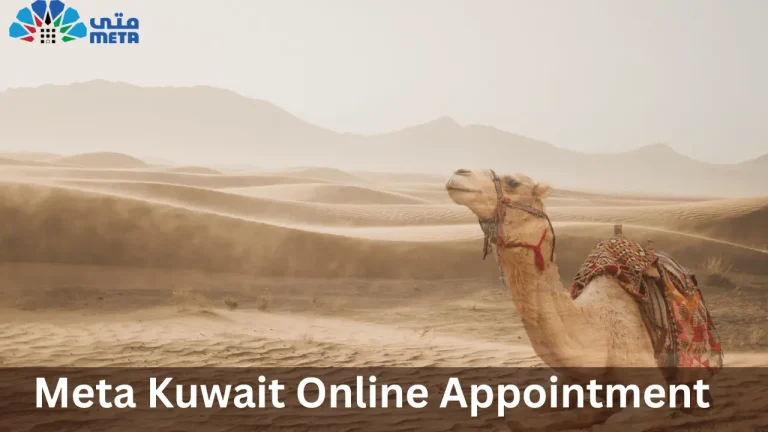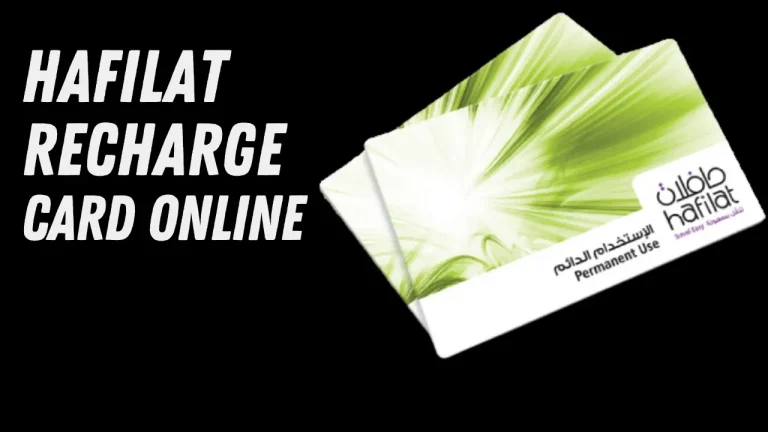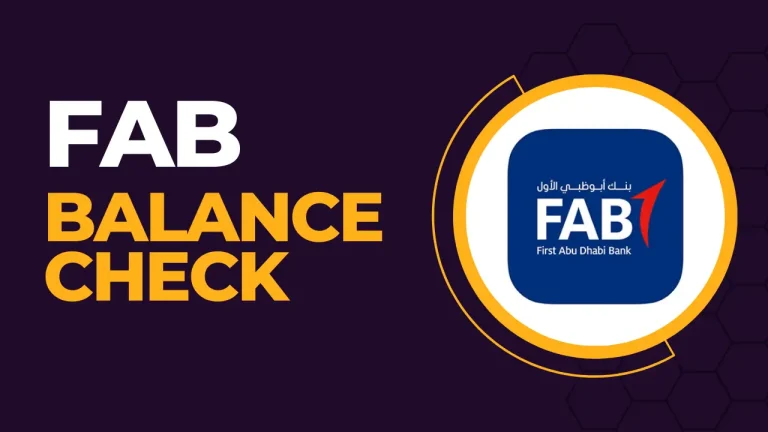Dubai Metro Map 2024 – A Complete Breakdown Of Luxurious Transport
The Dubai Metro Map serves as a crucial visual guide to the city’s extensive metro system, playing a pivotal role in its transportation infrastructure. With a population of approximately 3 million residents, Dubai, located in the United Arab Emirates, stands as a vibrant and bustling city.
Positioned geographically at the crossroads of Asia and Europe, Dubai finds itself surrounded on three sides by the vast expanse of the Arabian Desert, covering an impressive area of about 4,114 square kilometers. In recent decades, Dubai has undergone an unparalleled economic boom, propelling its impressive growth and development.
The rapid transit rail network in Dubai is operated by Keolis-MHI, a consortium comprising Keolis and Mitsubishi Heavy Industries. Both the Red Line and Green Line are operational, featuring fully automated and driverless trains. The stations, equipped with air-conditioning and platform edge doors, showcase a design by Aedas and were constructed by the Al Ghurair Investment group.
Inaugurated on September 9, 2009, by Mohammed bin Rashid Al Maktoum, the Dubai Metro stands as the inaugural urban train network in the Arabian Peninsula. Its launch witnessed an impressive uptake, with over 110,000 people, constituting nearly 10% of Dubai’s population, utilizing the metro in its initial two days. From its inception in September 2009 to February 2010, the metro carried a staggering 10 million passengers.
Dubai Metro, up until 2016, claimed the distinction of the world’s lengthiest driverless metro network, spanning an impressive 75 kilometers. This record was later reinstated in 2021 with the introduction of Route 2020. Maintaining its prominence, the Red Line, stretching over 52.1 kilometers, stands as the globe’s lengthiest driverless metro line.
Transforming Commutes: The Quest for a Rapid and Effective Transit Solution
Dubai, hailed as the UAE’s tourism hub, boasts iconic architectural wonders like Burj Al Arab and Burj Khalifa, luring millions of global visitors. Yet, the surge in tourists has strained the city’s local transport. In response, Dubai seeks an innovative express transport system to smoothly traverse the entire city.
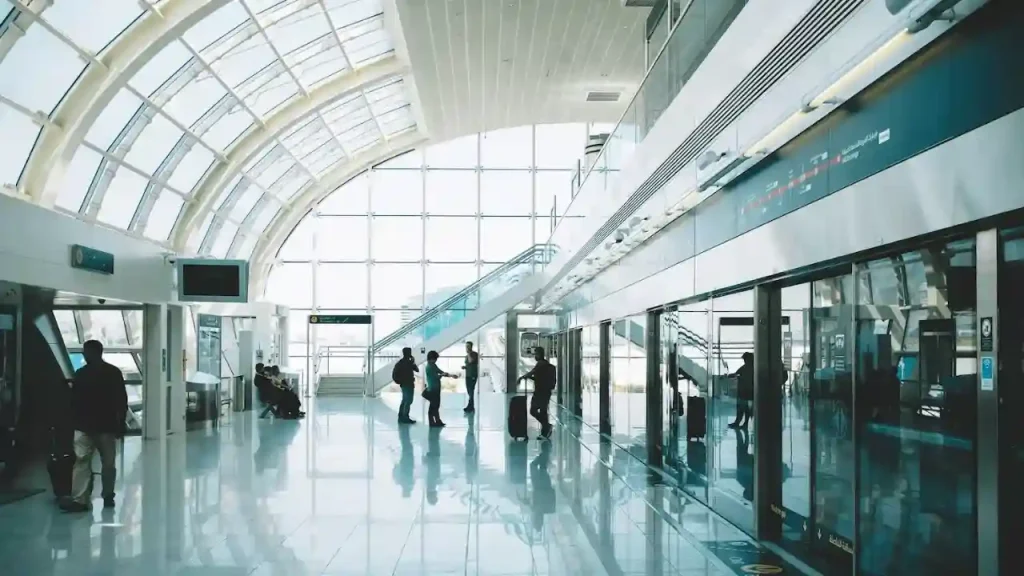
From Blueprint to Reality: Dubai Metro’s Tale of Construction, Connectivity, and Cost
Initiated by Sheikh Mohammed bin Rashid Al Maktoum’s vision, the Dubai Metro aimed to handle the anticipated 15 million visitors by 2010. The Dubai Rail Link (DURL) consortium secured a AED 12.45 billion/US$3.4 billion contract in 2005, covering the 35-kilometer Red and Green Lines, completed by 2010. Construction costs surged from AED 15.5 billion/US$4.2 billion to AED 28 billion/US$7.8 billion due to scope changes.
While expecting AED 18 billion/US$4.9 billion in income, authorities acknowledged potential non-profitability due to subsidized fares. Commencing in March 2006, construction faced delays, with only 10 Red Line stations opening on schedule in September 2009.
Resolving payment disputes, work resumed in February 2010. The remaining Red Line stations were declared complete by April 28, 2010. Further stations opened gradually, culminating in the final two Green Line stations on March 1, 2014, marking the project’s ultimate accomplishment despite challenges.
Dubai Metro Map 2023
The new and latest Dubai metro map is as follows.

To download a PDF version of the Dubai metro map pdf 2023, please click on this link.
Dubai Metro Routes
- Red Line: Between Centre point (R11) and Expo 2020 (R76)
- Green Line: Between Etisalat (G11) and Creek (G30)
Dubai Metro Timings
| Days | Timings |
|---|---|
| Monday to Thursday | 05:00 AM – 12:00 AM (Midnight) |
| Friday | 05:00 AM – 01:00 AM (Next day) |
| Saturday | 05:00 AM – 12:00 AM (Midnight) |
| Sunday | 08:00 AM – 12:00 AM (Midnight) |
Interchange Stations
- Union (R18/G20) and BurJuman (R19/G26) for interchange between Metro Red and Green Lines
- Jabal Ali (R38) for interchange between Metro Red and Branch Lines
- SOBHA REALITY (R36) and DMCC (R37) for interchange between Metro and Tram.
Latest Dubai Metro Map 2023
Dubai Metro comprises two operational lines integral to the city’s transport network, with an additional line under construction, demonstrating the ongoing commitment to enhancing public transit infrastructure. Dubai Metro has two existing lines, and a third one is set to open in 2021.
| Line | Opened | Route |
|---|---|---|
| Red Line | 2009 | Centrepoint to UAE Exchange (Jebel Ali) |
| Green Line | 2011 | Etisalat By e& to Creek |
| Route 2020 | Opening 2020 | Jabal Ali to Expo 2020 |
Dubai Metro Red Line
The Dubai Metro Red Line, stretching from Rashidiya to UAE Exchange, spans approximately 52.1 kilometers, including 5 kilometers of underground tracks. Construction commenced in 2005, culminating in completion by the end of 2009. Dubai metro map red line indicates the Red line.
The project, inclusive of the Green Line, incurred a total cost of around 7.6 billion US dollars, encompassing 29 stations. This equates to an average expenditure of approximately 102.2 million US dollars for each kilometer. Operating at an average speed of 47 km per hour, the total trip time on this line is estimated to be around 70 minutes.
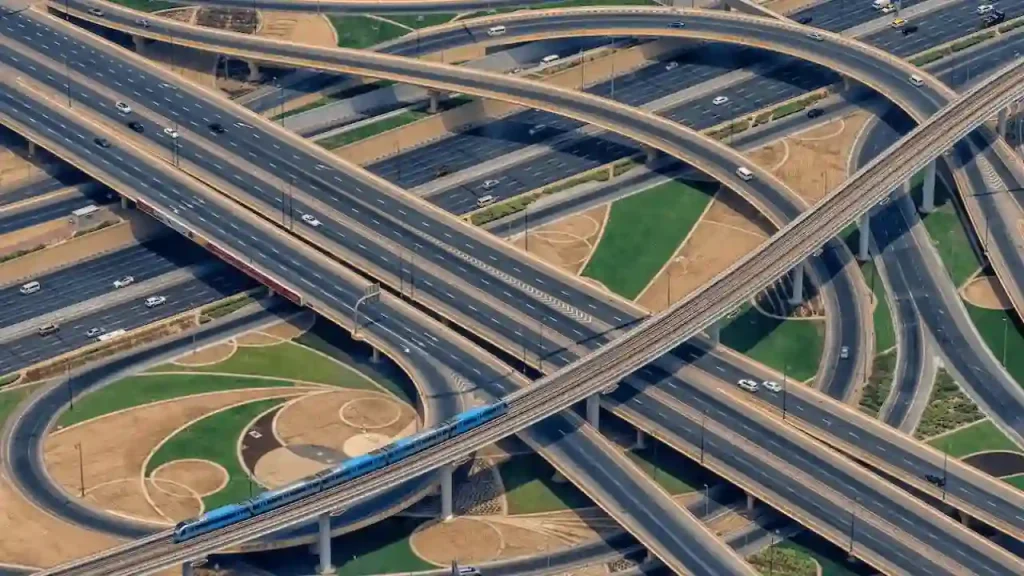
List of Red Line Stations
Dubai Metro Green Line
The Dubai Metro Green Line links Etisalat with Creek, featuring 20 operational stations along its 22.5-kilometer route, with 8 kilometers underground. Initiated in 2006, the line faced delays, pushing the official opening from the proposed March 2010 to September 2011.
Running parallel to the Red Line, the total project cost, encompassing the Green Line, reached approximately 7.6 billion US Dollars or 28 billion AED, resulting in an average cost of around 102.2 million per kilometer. The Green Line boasts a 40-minute trip time, with an average acceleration of about 38 km per hour.
List of Green Line Stations
Dubai Metro Route 2023
The extension of the Dubai Metro Green Line is envisioned to connect Nakheel Harbour and Tower to Expo 2020.Commencing construction in 2017 with an initial completion goal of late 2018, the line is currently inactive. As per the Road and Transportation Authority (RTA), it is slated to become operational by May 2020.
Covering a total length of approximately 14.5 km and featuring seven working stations, the estimated cost for this project stands at around 2.45 billion US Dollars, translating to an approximate cost of 186 million US Dollars per kilometer. Details regarding trip time and average speed are currently unavailable due to the line’s non-operational status.
Operational Details
The Dubai Metro is operated by the British public service provider group Serco, functioning under a contract with the Road and Transportation Authority (RTA) Dubai. In the year 2018, the Dubai Metro witnessed a ridership of around 204 million passengers, with 132 million utilizing the Red Line and 72 million on the Green Line.Since its inception in 2009, the total ridership has exceeded 1 billion trips, as reported by the RTA.
As of today, the Red Line operates with a frequency of one train every seven minutes, deploying 44 trains in service. In the stride of 2010, the fleet expanded to 51 trains, orchestrating a symphony that elevated peak hour capacity to embrace 11,675 passengers per hour on each side.
On the Green Line, with 19 trains in operation, the capacity stands at 6,395 passengers per hour on each side. Diving into theoretical realms, the Red Line unfurls its capacity, theoretically reaching up to 25,720 passengers per hour on each side, while the Green Line envisions accommodating 13,380 passengers per hour on each side.
Dubai Tram Routes
- Between Jumeirah Beach Residence 1 (01) and Al Sufouh (11)
Dubai Tram Timings
| Days | Timings |
|---|---|
| Monday to Saturday | 06:00 AM to 01:00 (Next Day) |
| Sunday | 09:00 AM to 01:00 (Next Day) |
Dubai Metro Fares
The Dubai Metro operates on a fixed fare system categorized into three tiers.
| Tier | Zones |
|---|---|
| Tier 1 | Less than three Zones |
| Tier 2 | Starts in Zone 1 and ends in neighboring Zone |
| Tier 3 | More than three Zones |
Nol Card Monthly Pass – Complete Fares 2023 For Dubai Metro

Dubai Metro Route Map
The Dubai Metro offers three types of route maps for passengers.
There are three types of Dubai Metro Map for the route.

Schematic Map
This simplified Dubai Metro Map displays only the stations along the routes of all three lines. Additionally, it includes transport zones, providing users with valuable information for fare calculation.
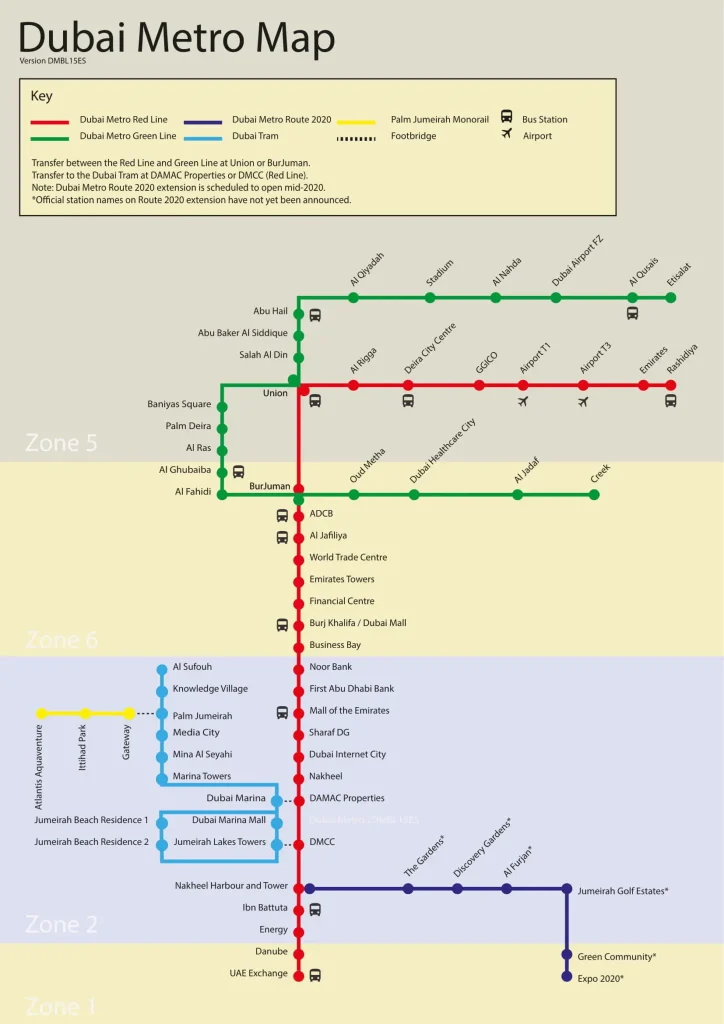
Interactive Map
This Dubai Metro Map illustrates the precise locations of all stations, complete with labels indicating nearby places. The interactive map also includes detailed information on transport zones.
Overlay Map
This Dubai Metro Map displays all three lines on the actual map of Dubai, providing a comprehensive view of the metro network across the city.
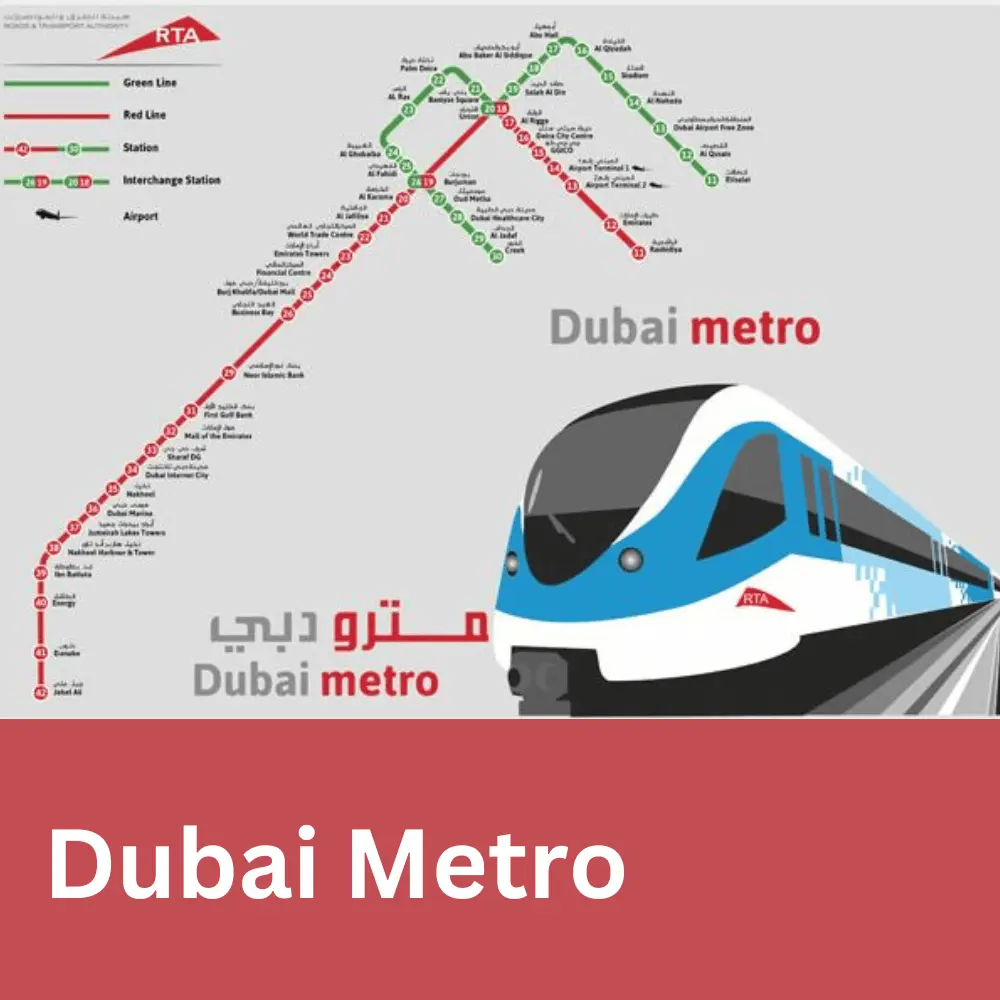
Trains Layout and Features
The Dubai Metro is globally recognized as one of the safest metro systems. It features a dedicated Metro police force available for emergencies, supported by an extensive network of over 3,000 CCTV cameras strategically placed in stations and trains. These cameras, under constant live monitoring by the metro police, enhance security measures and prevent any potential incidents.
To bolster communication during emergencies, an inbuilt radio system facilitates swift communication between the metro train and emergency forces, including the Metro police. In cases of medical emergencies, each train is equipped with an Emergency Call Box directly linked to both Metro Police and Ambulance Services.
The metro system adopts a clear layout for passenger convenience, incorporating designated cabins:
- Gold Class Cabin
- Women and Children Cabin
- Standard Cabin
Salient Features and Facilities of Gold Class Cabin
The Gold Class Cabin in the Dubai Metro offers additional features, albeit at a slightly higher cost. Luxury takes the forefront in the Gold Class Cabin, featuring individual leather seats with generous legroom and exclusive panoramic views. The cabin’s carpeted floors, enhanced lighting, and unique designs create an opulent atmosphere.
Accessible through a dedicated boarding door, the Gold Class Cabin also offers a specialized luggage compartment for passengers’ convenience. The seats are equipped with tray tables, providing a convenient surface when needed. Additionally, this section offers a separate high-speed internet connection for an enhanced travel experience.
Standard Cabin Salient and Features and Facilities
While the Standard Cabin in the Dubai Metro may not boast as many features, it still provides a comfortable and efficient travel experience. Notably, there are designated sections, with men restricted from entering the Women and Child section to ensure a safe and secure environment.
Violating this rule may result in a fine of up to $50. Each train has an impressive seating capacity of 400 passengers and spans a length of 75 meters. These trains exhibit a maximum acceleration of approximately 90 km per hour, emphasizing efficiency and reliability in transportation.
Elevating Lifestyle: The Distinctive Fusion of Luxury and Seamless Connectivity
The daily commute for many in Dubai has been significantly simplified by this system. Given the city’s reputation for opulent living, the Metro stands as a true embodiment of its lavish lifestyle. The Road and Transportation Authority (RTA) has implemented one of the world’s most advanced, comfortable, and reliable Metro systems.
The trains, equipped with air-conditioning, feature segregated sections for women/children and men. Beyond connecting Dubai internally, this Metro seamlessly extends its reach to neighboring emirates.

From Vision to Reality: A Closer Look at the Completion of Dubai Metro’s Key Lines
The Dubai Metro, managed by Keolis through its contract with the Roads & Transport Authority, exemplifies a seamless blend of efficiency and innovation. Its operational tenure, marked by renewals, saw a significant transition in March 2021 when the French-Japanese consortium of Keolis and Mitsubishi Heavy Industries assumed operations from September 8, 2021.
The Red Line, a lifeline of Dubai’s transit, orchestrates a rhythm of trains every 5 to 7 minutes during off-peak times, gracefully increasing to a minimum headway of 3 minutes 45 seconds (equivalent to 16 trains per hour) during peak hours. Technical intricacies occasionally lead to distinct departures for Red and Green Line trains.
With 44 trainsets in service and a storied history since 2010, the Red Line boasts a theoretical maximum design capacity of 25,720 passengers per hour, a testament to its pivotal role in city transport. The Green Line, originally designed to accommodate 6,395 passengers per hour in each direction, is currently served by 19 trains as of September 2014.
Designed to accommodate 13,380 passengers per hour with 60 trains in service, the Green Line complements its counterpart, contributing to Dubai’s intricate tapestry of connectivity and mobility.
Dubai Metro’s Legacy: A Tapestry of Architecture, Automation, and Innovation
The Metro’s architectural design was crafted by the international firm Aedas, a collaboration formed in 2002 through the union of three global companies. The implementation of Automatic Train Operation renders all Dubai Metro trains driverless, enhancing efficiency.
Notably, both trains and stations are fully air-conditioned, ensuring a comfortable journey. A distinctive feature of the metro is the inclusion of platform edge doors, while the trains boast window panels offering passengers a scenic view of the city during their ride.
Dubai Metro achieved global recognition for holding the title of the world’s longest driverless metro until 2016, covering an impressive route length of approximately 75 kilometers. While no longer holding the overall record, the Red Line still proudly stands as the world’s longest single-line driverless metro, encompassing a route length of about 52.1 kilometers.

Dubai Metro Stations
Aedas has applied distinctive architectural designs to each station of the Dubai Metro, categorizing them into five unique themes, each symbolizing different concepts:
Heritage Theme
The Heritage Theme is designed to convey the rich culture and history of the United Arab Emirates. While it doesn’t incorporate color effects, it encompasses numerous other elements. The essence of the theme revolves around incorporating engineering components reminiscent of traditional UAE structures, such as wind towers, oriels, alleyways, internal arches, and more.
This reinterpretation represents an enhanced and modernized approach. The stations inspired by heritage evoke the ambiance of traditional souqs in the region, contributing to a sense of cultural continuity. It’s worth noting that heritage-themed stations are relatively scarce compared to others in the network.
Earth Theme
The Earth Theme signifies the initiation of Dubai’s transition toward an urban lifestyle, symbolizing the resilience of the earth and soil. Characterized by a tan-brown color effect, this theme captures the essence of steadfastness and durability in its design.
Air Theme
This theme captures the joy and delight that Dubai extends to residents and visitors. Marked by a green color effect, it embodies the vibrant and enjoyable facets of the city.
Fire Theme
The Fire Theme embodies the vitality, strength, and unwavering determination exhibited by Dubai’s pioneers. Marked by an orange and red color effect, it encapsulates the spirit of energy and resolute determination.
Water Theme
This theme encapsulates the moral values championed by Dubai in its modern accomplishments. The Water Theme adopts a blue-white color scheme, symbolizing purity and tranquility.
Facilities at Dubai Metro
Dubai Metro offers various amenities to enhance the experience of its users. Please refer to the list below for details.
Parking
Dubai Metro has developed three multi-level parking facilities at key stations, collectively accommodating over 8,000 vehicles. These parking spaces are complimentary for metro users, providing a convenient option for commuters who wish to park their cars at the station and utilize the metro for their daily commute or travel to various destinations.
Among these facilities, two are affiliated with the Red Line, while one serves the Green Line. The parking capacities for each are as follows:
- Rashidiya Metro Station’s parking area boasts a capacity of more than 2,700 cars. (Red Line)
- The parking facility at Nakheel Harbour and Tower Metro Station can accommodate over 3,000 vehicles, belonging to the Red Line.
- Etisalat Metro Station’s parking area provides space for more than 2,300 cars. (Green Line)
Facilities for Handicapped
The UAE places significant importance on the well-being of disabled individuals, referred to as ‘People of Determination.’ The approach towards this community is positive, allowing them to travel for free simply by obtaining their Nol card. Additionally, facilities such as elevators and tactile guidance paths have been implemented to enhance accessibility for people with disabilities.
Other Additional Facilites
Additional facilities include:
- Emergency Stop Buttons: Every train is equipped with emergency stop buttons, ensuring immediate response in case of unforeseen situations.
- Fire Extinguishers: Fire extinguishers are strategically placed in each section of the train, enhancing safety measures for passengers.
- Metro Police Patrol: The Metro Police maintains a constant presence, patrolling to ensure the safety and security of passengers throughout the metro network.
- Free Wi-Fi: Enjoy the convenience of free Wi-Fi available both on trains and at stations, providing connectivity for passengers during their journeys.
Conclusion
In the end of this article I can say that the Dubai Metro stands as a vital component of the city’s transportation infrastructure. This article has furnished a thorough guide to the 2023 Dubai Metro Map, encompassing details on routes, timings, and interchange stations. Whether you call Dubai home or are a visitor, familiarizing yourself with the updated Dubai Metro Map is crucial for seamless navigation throughout the city.
The metro system provides a swift and cost-effective means of traversing Dubai, offering the added benefit of bypassing traffic congestion and parking challenges. Undoubtedly, it will continue to be a cornerstone of Dubai’s transportation network, contributing significantly to the city’s connectivity and accessibility.
As the world making progress we, shall witness to see changes of Dubai Metro map 2025 and more facilities will be provided to the people of Dubai and its tourists.
You May Also Like:- Rashidiya Emirates ID Center Timings 2023-Schedule Your Visit Now




